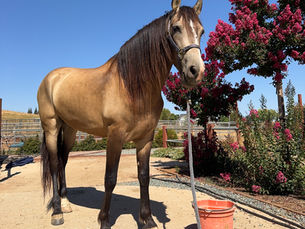The Cost of Owning a Horse: Calculator and Guide
- Horse Education Online
- Sep 10
- 4 min read
Updated: Sep 16

Owning a horse can be a fulfilling dream for many, but it's essential to understand the financial responsibilities it entails. As we look ahead to the end of 2025 and the beginning of 2025, having a clear picture of these costs can help you make informed choices. In this post, we will break down the average costs of horse ownership, ensuring you're well-prepared for this commitment.
After reading this article, research your area and use our Annual Horse Ownership Cost Calculator with automatic totals, an emergency-fund estimator, and a separate emergency planner sheet.
Download it here:
What’s inside
Routine sheet: line items for board, feed, vet, farrier, tack/supplies, training, insurance. Enter Unit cost and adjust Qty per year; Annual cost calculates automatically.
Emergency sheet: common incident types (colic, lacerations, diagnostics, rehab, transport, end-of-life) so you can pre-plan realistic reserves or record past outlays.
Summary sheet:
Pulls the Routine subtotal automatically.
Lets you set an emergency fund target by percentage (default 15%) and/or a flat $ amount (default $3,000). The calculator uses the larger of the two.
Shows Expected annual total and monthly average.
Understanding the Costs of Owning a Horse
Horse ownership comes with a variety of expenses. These include initial purchase costs, ongoing care, and extra costs that may arise. According to a study published in the Journal of Equine Veterinary Science, the annual cost of horse ownership can range from $3,000 to $10,000 or more. The actual expenses depend on factors like location, horse type, and how involved you are in your horse’s care.
Here’s a closer look at the major cost categories:
1. Purchase Price: The cost of buying a horse varies greatly based on several factors, such as breed, training, age, and pedigree. For example, a well-trained, well-bred horse can cost anywhere from $10,000 to $20,000, while younger "greener" horses may be available for $2,500 or less.
2. Boarding: If you do not have the facilities to keep your horse at home, you will likely need to pay for boarding. This expense can vary significantly by region.
3. Feed and Nutrition: Quality feed is crucial for your horse's health. The costs can differ depending on the type of feed and local availability. Annual feed costs can range from $1,200 to $3,000.
4. Veterinary Care: Regular check-ups, vaccinations, and emergency care are non-negotiable expenses. On average, this can add up to about $600 to $1,500 annually.
5. Farrier Services: Keeping your horse's hooves healthy is another essential expense. Depending on your horse’s needs, this may cost between $400 and $1,200 per year.
6. Insurance: Many horse owners choose to get insurance for both medical costs and liability coverage. This can start at around $300 annually but can climb higher based on coverage.
7. Miscellaneous Costs: This covers equipment, training, and transportation. Total miscellaneous expenses can add up to several hundred or even thousands of dollars each year.
Understanding these costs can help make horse ownership more manageable.
Routine Annual Expenses
These are recurring costs necessary to maintain the horse’s health and well-being. Costs can vary widely by region, boarding style (full board vs. self-care), and horse needs.
1. Housing & Feeding
Boarding fees (pasture board or stall board, typically charged monthly)
Hay and forage (if not included in board)
Grain/concentrates (specialty feeds if required)
Bedding (if you maintain your own stall)
2. Healthcare
Routine veterinary care
Annual physical exam
Core vaccinations (tetanus, EEE/WEE, West Nile, rabies, influenza, etc.)
Coggins test
Fecal egg count testing
Deworming program (scheduled throughout the year)
Dental care (floating teeth, usually once or twice per year)
3. Hoof Care
Farrier visits every 6–8 weeks
Trim only
Shoes (front or full set depending on horse’s needs)
4. Equipment & Supplies
Basic tack maintenance (saddles, bridles, halters, blankets)
Grooming supplies and replacements (brushes, hoof picks, fly spray)
Stable supplies (buckets, pitchforks, storage bins)
5. Training & Riding
Riding lessons or trainer fees (if applicable)
Clinic or show entry fees (if competing)
Transportation (fuel, trailer maintenance if hauling yourself)
6. Insurance
Mortality or major medical insurance (optional but recommended)
Liability insurance (especially if the horse is on your property)
Emergency & Unexpected Costs
It’s essential to budget for unplanned expenses, as horses are prone to injuries and illnesses.
1. Veterinary Emergencies
Colic treatment or surgery
Lacerations or injuries needing sutures
Laminitis treatment
Diagnostic imaging (X-rays, ultrasounds, endoscopy)
After-hours emergency call fees
2. Special Medications or Therapies
Prescription drugs (antibiotics, anti-inflammatories)
Joint injections
Rehab services (shockwave therapy, hydrotherapy, etc.)
3. Equipment & Property Repairs
Broken fencing or gates if the horse damages them
Replacement of major tack items (saddles, trailers)
4. Emergency Transportation
Trailering to a veterinary hospital
Professional emergency hauler fees
5. End-of-Life Costs
Euthanasia and disposal/cremation fees (rare, but can be significant)
How to Estimate
Routine Costs: Add up the monthly amounts for board, feed, farrier, and routine vet care, then multiply by 12 for an annual estimate.
Emergency Fund: Many owners set aside an additional 10–20% of their annual routine budget, or a flat $2,000–$5,000, for emergencies.
Use our Annual Horse Ownership Cost Calculator below:






